Cuba/Africa: An Inspiring Example of Human Survival
Yusimí Rodríguez López

HAVANA TIMES – A few weeks ago I met Dr. Emma Christopher, director of the documentary “They are We” and author of the article “Cubans visit their ancestral home in Africa” published in HT. I asked her how an academic ended up directing a documentary.
Emma: Others have done the same. My students belong to a generation that has grown up with the Internet and with multiple audio-visual resources and they respond very differently to images than to written materials. I began with the desire to show them a more balanced image of Africa than the one occasionally offered by the media, which presents only bad news.
I was working on a project to trace what had happened to the slaves following the closure of a slave factory in Liberia. During the course of this, I filmed images of certain ceremonies that people in Perico, near Matanzas, Cuba, had preserved, to see what kind of situation these slaves from that factory might have ended up in. Once back in Liberia, there was a local conflict and we had to flee. We asked people what to do, where to go. They ended up seeing the material about Perico on my laptop and they recognized the dances and songs. That’s how the project began.
Three weeks after making her acquaintance, I met with Emma and her field producer and head of still photography for the film: Sergio Leyva, author of “Cuba/Africa: An old slave trading place” also published in HT.
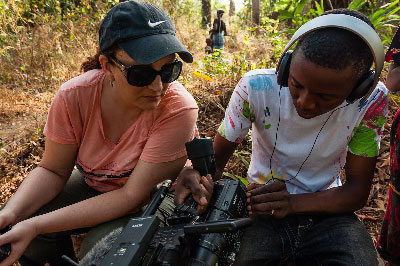
HT: How did a white person from the first world become interested in a topic like the slave trade? White guilt?
Emma: I feel that it’s almost impossible to see these places in Africa without feeling guilty. I grew up in the northwest of England, which was a center of the Industrial Revolution with many cotton mills. As children we would be taken there and they would tell us that during the American Civil War, people in the region were starving because the cotton mills couldn’t get the cotton they needed for production.
But they never explained that it was because the slaves who had been forced to work in the United States cotton plantations stopped doing so when the war broke out. I found this out when I traveled to the US, before entering University.
When I returned I knew that – unlike others who were studying Ancient Greece or the world wars – I wanted to focus on that topic. I was very fortunate because my university had appointed a US professor who was studying slavery. I studied American history and American slavery.
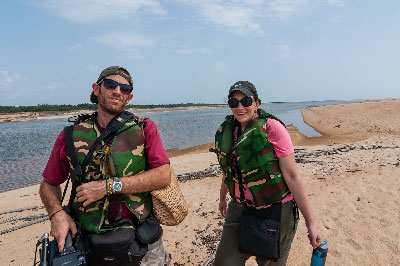
HT: Sergio, at the end of your article you affirm that you can’t avoid a slight sense of guilt, even though you are from the third world and that only in Cuba would you be considered “white”.
Sergio: This country was built by slaves. They provided the labor necessary for the production of sugar, which was the country’s principal export. They were carried here via long ocean crossings that many didn’t survive. In the cane plantations, their average survival was approximately seven years. In this way, they built up other nations while Africa was left decimated and stagnated in time.
HT: But three Sundays ago, when I saw the first images from the film, you stated that you missed it there. I only saw poverty. What was there to miss?
Both at once: “The people!”
Sergio: They gave me back the notion that human beings are intrinsically good. They have been through a lot, they have the most screwed up history that you can imagine, and even so they’re capable of smiling, helping you without expecting any return and helping each other.
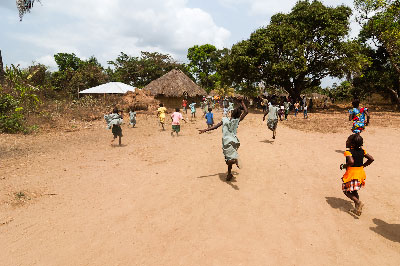
Emma: They have such an incredible community spirit, especially in the villages, but even in the city.
Sergio: If there’s a bottleneck in traffic, someone stops to help.
Emma: Our cameraman, Barmy (his real name is Lansana) grew up in the street due to the war. Because the neighbors knew that he was a smart kid, they would give him money for his school fees, because he was like the hope of the community. In Mukpangumba, they had no school untilrecently. Salomon, whose father died in the civil war, also talks about how the community helped his family pay for his studies, so he could learn English and become the voice of the community when anyone came from outside.
One of things I love most about what I am doing is that when I introduce Mukpangumba in the film, you see this very poor village. They don’t have running water, they drink from the river, there’s no infrastructure, no doctors, nothing. Then you hear Salomon’s voice, this really eloquent English-speaking voice. And it is a beautiful contradiction with what people expect. I know that they must feel very proud that their investment paid off. Salomon is now a teacher in the school.
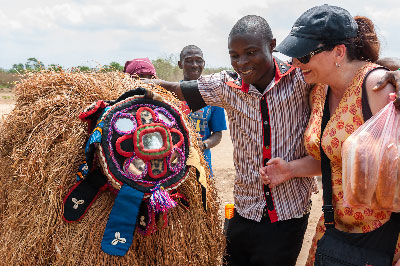
Sergio: Barmy supports many social causes. He gives talks to children, encouraging them to go to school. He’s a rapper and his most famous song is on YouTube, it’s called HIV Dangerous.
Emma: There’s a contradiction between their material poverty and their social and cultural wealth.
HT: How has this documentary changed your lives?
Emma: Even if nobody ever saw the documentary, the people of Mukpangumba and of Perico have changed my life in so many fantastic and positive ways. They did so by showing me this incredible generosity and demonstrating that it’s possible to establish these kinds of connections with people.
Sergio: Just the way they have welcomed us in Perico and Mukpangumba every time we’ve gone there has been fantastic.
Emma: Baggie, who appears dancing in the film, is always smiling, even though his personal history is tough. I once asked him off-camera why he always looked so happy. He told me that it was his job to help us and make us feel good while we did ours: whatever happened with his life was for him to deal with.
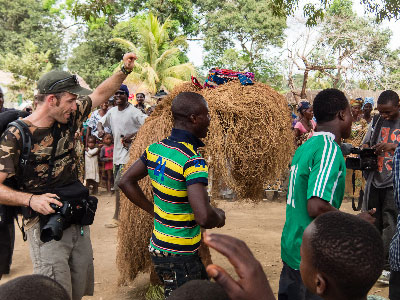
Sergio: When Alfredo, one of the four Cubans from Perico, was collecting bunches of palm seeds together with those of Sierra Leone, he remarked that we needed to learn from those people: that westerners should stop crying and learn.
HT: Any special anecdotes?
Sergio: The reception the first time that I went to Mukpangumba will stay in my mind forever. I had walked two miles in the heat, carrying my things, without knowing what to expect. Then all of these children came running. I began to hear the drums. When you finally reach the soccer field, they are all gathered there for the welcoming ceremony. The people danced with guano masks. It was very spontaneous. I don’t like to dance and I don’t know how, but that day I had to do it.
Emma: On my second trip to the village to show them a video of the Cubans from Perico, who had seen them on video and were sending them greetings, they asked me to stay, to be more than just a tourist. I explained that our cameras needed to have their batteries charged and that we were susceptible to malaria. They said that they would buy a generator, buy gasoline and find mosquito nets for us. I couldn’t believe that they would try to give us something. We decided that if all they wanted was for us to be with them in the village, then we would buy the generator and buy the gasoline ourselves.

When we planned the trip with the four Cubans, the only concern of the villagers was how to make us feel good. They wanted to find spoons for us. They said that we shouldn’t be carrying tents because they would make space for all of us in their houses. They wrote words and phrases in Spanish to communicate with the Cubans.
Sergio: On our first stay, before the trip with the four Cubans from Perico, they had made a beautiful toilet covered with raffia and a little stone walkway for us. When we arrived with the Cubans, they had made it larger and improved it.
HT: Do you know of any similar projects?
Emma: The documentary “The language you cry in” by the US professor Joseph Oppala from 1999; “Leaping the Atlantic” by Jesús Garcia and one titled “Little Senegal” from 2001, I don’t know the name of the director.
HT: What do you expect to accomplish with this documentary?
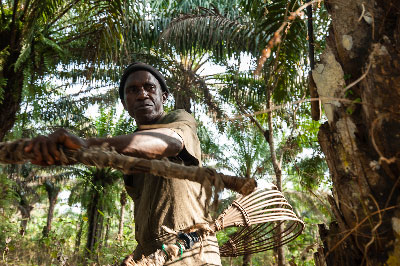
Emma: Inspire other people of African origin in the Americas, who have conserved some song or dance, to give it a try. Some friends and colleagues have asked what the people of Mukpangumba need. A pump to have running water would save children’s lives. I didn’t begin the project with that idea, but it would be fantastic.
Sergio: The four Cubans now know where they come from and have been accepted there. As Alfedo said, now they don’t feel so lost.
HT: But there’s a moment in your article, Dr. Christopher, when you assure us that it’s impossible to demonstrate that the ancestors of the four Cubans really belonged to that community.
Emma: I meant that it’s impossible to prove it scientifically with DNA testing, because there are many other ancestors to take into account on both sides. Perhaps in the future a way may be found. At present, among the ten or eleven African songs that the Cubans have preserved, we could identify five.
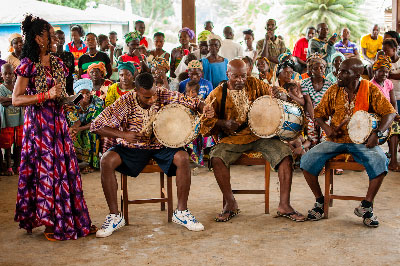
In Sierra Leone they recognized these songs, even though some words had been changed. They can sing them together, each with their own version, because the melody was preserved. The same thing happened with the dances. Among the five or six songs that we couldn’t identify, two or three have some connections: the yumbo-yamba song for example. Even though they couldn’t recognize the song, those from Sierra Leone said that yumbo-yamba is a very important plant that is used to cure malaria.
Sergio: It’s admirable that Josefa (the ancestor of the four Cubans) managed to preserve her traditions and her religion in the midst of slavery, in order to transmit them to her descendents; and that these were maintained during the neocolonial period and during the Revolution, when racism was supposed to have been eradicated, but we know it wasn’t, and all religious practices were forbidden.
Emma: Back to your question: What do I want to achieve with the documentary? Well, if there’s anyone out there of African origin who feels pride in seeing it that would be the best present of all. In the United States, the Afro-Americans are very proud of being so, even though they may not know what part of Africa they are from. I haven’t seen that kind of pride here, and that’s sad. The descendents of Africans are an inspiring example of human survival.
